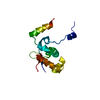+ Open data
Open data
- Basic information
Basic information
| Entry | Database: PDB / ID: 4pta | ||||||
|---|---|---|---|---|---|---|---|
| Title | Structure of MDR initiator | ||||||
 Components Components | Replication initiator protein | ||||||
 Keywords Keywords |  REPLICATION / initiation / REPLICATION / initiation /  multidrug resistance / multidrug resistance /  PROTEIN BINDING PROTEIN BINDING | ||||||
| Function / homology | Replication initiator A, N-terminal / Replication initiator protein A, C-terminal domain / Replication initiator protein A (RepA) N-terminus / Replication initiator protein A C-terminal domain / Replication initiator protein / Replication initiator protein Function and homology information Function and homology information | ||||||
| Biological species |   Staphylococcus aureus subsp. aureus (bacteria) Staphylococcus aureus subsp. aureus (bacteria) | ||||||
| Method |  X-RAY DIFFRACTION / X-RAY DIFFRACTION /  SYNCHROTRON / SYNCHROTRON /  SIRAS / Resolution: 2.6003 Å SIRAS / Resolution: 2.6003 Å | ||||||
 Authors Authors | Schumacher, M.A. | ||||||
 Citation Citation |  Journal: Proc.Natl.Acad.Sci.USA / Year: 2014 Journal: Proc.Natl.Acad.Sci.USA / Year: 2014Title: Mechanism of staphylococcal multiresistance plasmid replication origin assembly by the RepA protein. Authors: Schumacher, M.A. / Tonthat, N.K. / Kwong, S.M. / Chinnam, N.B. / Liu, M.A. / Skurray, R.A. / Firth, N. | ||||||
| History |
|
- Structure visualization
Structure visualization
| Structure viewer | Molecule:  Molmil Molmil Jmol/JSmol Jmol/JSmol |
|---|
- Downloads & links
Downloads & links
- Download
Download
| PDBx/mmCIF format |  4pta.cif.gz 4pta.cif.gz | 37.3 KB | Display |  PDBx/mmCIF format PDBx/mmCIF format |
|---|---|---|---|---|
| PDB format |  pdb4pta.ent.gz pdb4pta.ent.gz | 25.9 KB | Display |  PDB format PDB format |
| PDBx/mmJSON format |  4pta.json.gz 4pta.json.gz | Tree view |  PDBx/mmJSON format PDBx/mmJSON format | |
| Others |  Other downloads Other downloads |
-Validation report
| Arichive directory |  https://data.pdbj.org/pub/pdb/validation_reports/pt/4pta https://data.pdbj.org/pub/pdb/validation_reports/pt/4pta ftp://data.pdbj.org/pub/pdb/validation_reports/pt/4pta ftp://data.pdbj.org/pub/pdb/validation_reports/pt/4pta | HTTPS FTP |
|---|
-Related structure data
- Links
Links
- Assembly
Assembly
| Deposited unit | 
| ||||||||
|---|---|---|---|---|---|---|---|---|---|
| 1 | 
| ||||||||
| Unit cell |
|
- Components
Components
| #1: Protein | Mass: 15518.831 Da / Num. of mol.: 1 Source method: isolated from a genetically manipulated source Source: (gene. exp.)   Staphylococcus aureus subsp. aureus (bacteria) Staphylococcus aureus subsp. aureus (bacteria)Strain: USA300 / Gene: repA, SAUSA300_pUSA030001 / Production host:   Escherichia coli (E. coli) / References: UniProt: Q2FDD7, UniProt: A0A0H2XIV8*PLUS Escherichia coli (E. coli) / References: UniProt: Q2FDD7, UniProt: A0A0H2XIV8*PLUS |
|---|---|
| #2: Water | ChemComp-HOH /  Water Water |
-Experimental details
-Experiment
| Experiment | Method:  X-RAY DIFFRACTION / Number of used crystals: 1 X-RAY DIFFRACTION / Number of used crystals: 1 |
|---|
- Sample preparation
Sample preparation
| Crystal | Density Matthews: 2.56 Å3/Da / Density % sol: 51.92 % |
|---|---|
Crystal grow | Temperature: 275 K / Method: vapor diffusion, hanging drop / pH: 5.6 Details: 1 M Citrate, pH 5.6, VAPOR DIFFUSION, HANGING DROP, temperature 275K |
-Data collection
| Diffraction | Mean temperature: 100 K |
|---|---|
| Diffraction source | Source:  SYNCHROTRON / Site: SYNCHROTRON / Site:  ALS ALS  / Beamline: 8.3.1 / Wavelength: 1 Å / Beamline: 8.3.1 / Wavelength: 1 Å |
| Detector | Type: ADSC QUANTUM 315r / Detector: CCD / Date: Mar 23, 2012 / Details: mirrors |
| Radiation | Monochromator: si / Protocol: SINGLE WAVELENGTH / Monochromatic (M) / Laue (L): M / Scattering type: x-ray |
| Radiation wavelength | Wavelength : 1 Å / Relative weight: 1 : 1 Å / Relative weight: 1 |
| Reflection | Resolution: 2.6→67 Å / Num. all: 5120 / Num. obs: 5166 / % possible obs: 99 % / Observed criterion σ(F): 0 / Observed criterion σ(I): 0 / Redundancy: 3.5 % / Rmerge(I) obs: 0.057 / Rsym value: 0.06 / Net I/σ(I): 13.8 |
| Reflection shell | Resolution: 2.6→2.67 Å / Redundancy: 2.44 % / Rmerge(I) obs: 0.313 / Mean I/σ(I) obs: 2.7 / Rsym value: 0.332 / % possible all: 91.7 |
- Processing
Processing
| Software |
| |||||||||||||||||||||||||||||||||||
|---|---|---|---|---|---|---|---|---|---|---|---|---|---|---|---|---|---|---|---|---|---|---|---|---|---|---|---|---|---|---|---|---|---|---|---|---|
| Refinement | Method to determine structure : :  SIRAS / Resolution: 2.6003→23.62 Å / SU ML: 0.39 / σ(F): 1.46 / Phase error: 28.53 / Stereochemistry target values: ML SIRAS / Resolution: 2.6003→23.62 Å / SU ML: 0.39 / σ(F): 1.46 / Phase error: 28.53 / Stereochemistry target values: ML
| |||||||||||||||||||||||||||||||||||
| Solvent computation | Shrinkage radii: 0.72 Å / VDW probe radii: 1 Å / Solvent model: FLAT BULK SOLVENT MODEL / Bsol: 63.92 Å2 / ksol: 0.45 e/Å3 | |||||||||||||||||||||||||||||||||||
| Displacement parameters |
| |||||||||||||||||||||||||||||||||||
| Refinement step | Cycle: LAST / Resolution: 2.6003→23.62 Å
| |||||||||||||||||||||||||||||||||||
| Refine LS restraints |
| |||||||||||||||||||||||||||||||||||
| LS refinement shell |
|
 Movie
Movie Controller
Controller

















 PDBj
PDBj
